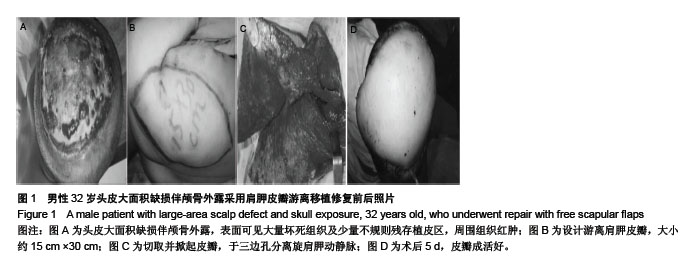| [1]张诚,刘毅,刘萍,等.皮肤软组织扩张术美容修复烧伤后头皮缺损合并颅骨外露[J].中国美容医学,2009,18(12):1717-1719.
[2]毛远桂,熊宏兰,张志安,等.大面积头皮缺损并颅骨外露的治疗[J].江西医学院学报,2006,46(4):78-79.
[3]Fischer JP,Sieber B,Nelson JA,et al.A 15-year experience of complex scalp reconstruction using free tissue transfer-analysis of risk factors for complications. Reconstr Microsurg.2013;29(2):89-97.
[4]李岩,张志华,孔祥红,等. 头皮缺损颅骨失骨膜外露的修复方法探讨[J].中华整形外科杂志,2008,24 (1):77.
[5]袁好军,安静,孙宇航,等.帽状腱膜下筋膜瓣加植皮Ⅰ期修复头皮大面积缺损伴颅骨外露[J].中国美容医学,2014,23(7):526-528.
[6]马显杰,郑岩,夏文森,等.软组织扩张术治疗大面积头面部瘢痕[J].中华整形外科杂志,2008,24(6):447-449.
[7]Gundeslioglu AO,Selimoglu MN,Doldurucu T,et al.Reconstruction of large anterior scalp defects using advancement flaps.J Craniofac Surg.2012;23(6):1766-1769.
[8]姜平,刘晓军,罗勇,等.头皮扩张皮瓣移植分期修复跨发际的头面部大面积缺损[J].中华显微外科杂志,2012,35 (1):64-65.
[9]王明刚,汪洪源,水庆付,等.头皮巨大肿瘤的外科修复与重建[J].安徽医学,2008,29(3):227.
[10]李晓静,宁金龙,高学宏,等.大面积头皮缺损及颅骨外露的显微外科修复[J].中华显微外科杂志,2004,27:30-31.
[11]Gundeslioglu O,Altundag O,Allundag K,et al..Closure of large scalp defects by modified gilles triple scalp in patients with scalp tumors. Plast Reconstr Surg.2005;116:1813-1814.
[12]汪洪源,王明刚,杜晓扬,等. 改进的游离背阔肌皮瓣修复巨大头皮恶性肿瘤切除后软组织缺损[J].安徽医学,2010,31(12): 1432-1434.
[13]吴琳,宋良玉,康久杰.头皮缺损修复方法的选择与探讨[J].中华整形外科杂志,2002,18(2):125-126.
[14]徐路生,郭凡,杜学亮,等.游离串联皮瓣修复颅骨外露头皮缺损的应用[J].岭南现代临床外科,2013,13(6):500-502.
[15]汤海萍,滕国栋,姜凯. 游离皮瓣在颅骨外露的头皮缺损中的应用[J].中国美容医学,2013,2(4):431-433.
[16]刘强,张正之,韩西城.游离大网膜移植治疗烧伤后颅骨缺损五例[J].中华整形烧伤外科杂志,1995,11(2):8.
[17]黄运严,谭海涛,覃秋海,等.应用游离股前外侧皮瓣修复头面部软组织缺损15例报告[J].广西医学,2009,31(7):1048-1049.
[18]王炜,李华.游离股前外侧皮瓣一期修复头皮鳞状细胞癌术后大面积缺损[J].实用医学杂志,2011,27(21):3984-3985.
[19]纪影畅,蔡湘娜,许宏权,等.以皮肤软组织扩张术为主的联合方案修复头面部大面积瘢痕畸形[J].中国美容整形外科杂志,2012, 23(1):41-44.
[20]刘柳,杨磊,赵明朝,等.游离股前外侧穿支皮瓣穿支血管的临床分类及意义[J].中华整形外科杂志,2012,28(4):291-293.
[21]黎洪棉,高建华,姜平,等.头面部皮肤恶性肿瘤手术切除后的整复治疗与评价[J].中国美容整形外科杂志,2010,21:220-222.
[22]洪小芳,孟宏,黄建华,等.游离股前外侧穿支皮瓣在头皮缺损中的应用[J].岭南现代临床外科,14(2):165-167.
[23]屈志刚,刘育杰,丁小珩,等. 应用游离胫后动脉穿支皮瓣修复头皮大面积皮肤缺损[J].中国修复重建外科杂志,2011,25(9): 1147-1148.
[24]Gilbert A,Teot L.The free scapular flap.Plast Reconstr Surg. 1982;69:601-604.
[25]李养群,徐 军,李森恺,等.肩胛游离皮瓣修复面颈部皮肤缺损[J].中国修复重建外科杂志,2000,14(4):205-206.
[26]吴晓明,孙 奎,耿琪英,等.带血管蒂肩胛游离皮瓣修复创伤后颅面缺损[J].创伤外科杂志,2008,10(3):219-221.
[27]鲍世威,杨明勇,李森恺,等.肩胛游离皮瓣修复大面积难愈性骨外露创面[J].中华整形外科杂志,2008,24(2):160-161.
[28]杨明勇,李式瀛,李森恺,等.旋肩胛动脉升支的解剖学研究[J].中华烧伤整形外科杂志,1996,12(4):293-295.
[29]李养群,李森恺,杨明勇,等.横过中线的肩胛游离皮瓣移植[J].中华烧伤整形外科杂志,1999,15(4):257-258.
[30]Saijo M.The vascular territories of the dorsal trunk:A reappraisal for potential flap donor sites.Br J Plast Surg. 1978; 31:200-208.
[31]唐欣,马婷婷,秦永平,等.游离肩胛区骨皮瓣在舌和口底及下颌骨联合缺损修复中的应用[J].中国美容医学,2009,18(3):315-317.
[32]Saijo M.The vascular territories of the dorsal trunk:A reappraisal for potential flap donor sites.Br J Plast Surg. 1978; 31:200-208.
[33]焦鹏,刘元波,战秋衡,等. 预扩张肩胛皮瓣在胸部瘢痕修复中的应用[J].中国美容医学,2009,18(3):754-756.
[34]刘祥厦,唐庆,曾瑞曦,等.大面积头皮缺损修复的探讨[J].中华损伤与修复杂志:电子版,2013,8(3):283-285.
[35]蔡宝仁,许辉,傅国友,等.肩胛下血管蒂组织瓣的解剖及其临床应用.解剖学研究,2001,23:9-10.
[36]霍然,李森恺,李养群,等.跨越人体中线肩胛皮瓣的微血管造影研究[J].中华整形外科杂志,2004,20(4):262-264.
[37]雷少榕,黄晓元,龙剑虹,等.游离肩胛皮瓣修复足部皮肤软组织缺损疗效评价[J].中国医学工程,2004,12(5):76-77.
[38]Kawamura K, Yajima H, Kobata Y, et al. Anatomy of Y-Shaped configurations in the subscapular arterial system and clinical application to harvest in flow-through flaps.Plast Reconstr Surg. 2005;116(4): 1082-1089.
[39]关志广,梁耀婵,张志平,等.肩胛游离皮瓣修复面部皮肤软组织缺损.中国美容医学,2004,13:39-40.
[40]Zumiotti AV,Teng Hw,Ferreira Mc.Treatment of post-traumatic tibial osteomyelitis using microsurgical flap.J Reconstr Microsurg.2003;19:163-171.
[41]凌宏量,张路灯,陈国荣.游离肩胛皮瓣移植修复颅面部皮肤软组织缺损[J].广西医学,2012,34(6):766-767.
[42]徐军, 李森恺,李养群, 等.以旋肩胛动脉升支和降支为主轴血管的肩游离皮瓣[ J]. 中华整形外科杂志,1993,9:247-249.
[43]J Xu, S K Li, YQ Li,et al. Superior extension of the parascapular free flap for cervical burn scar contracture. Plast Reconstr Surg.1995,96:58-62. |

